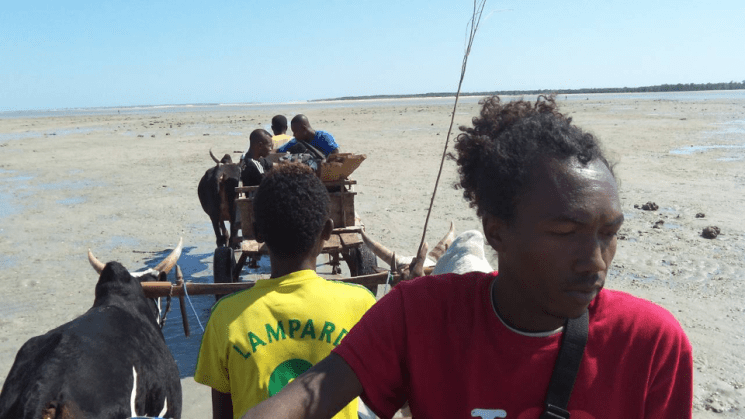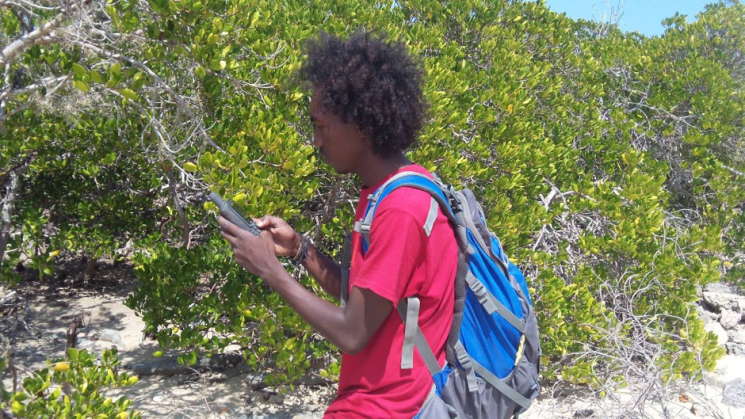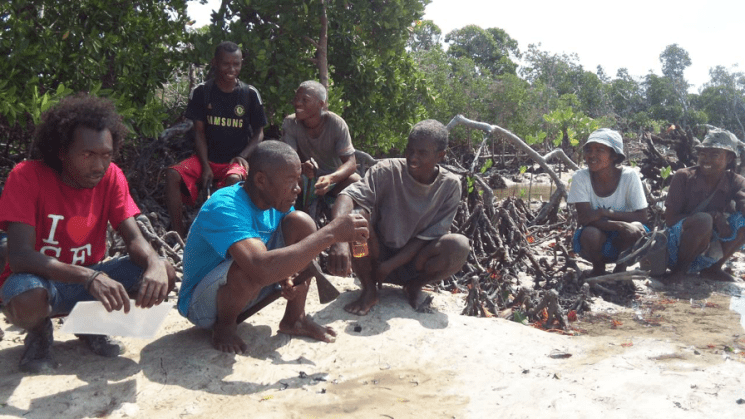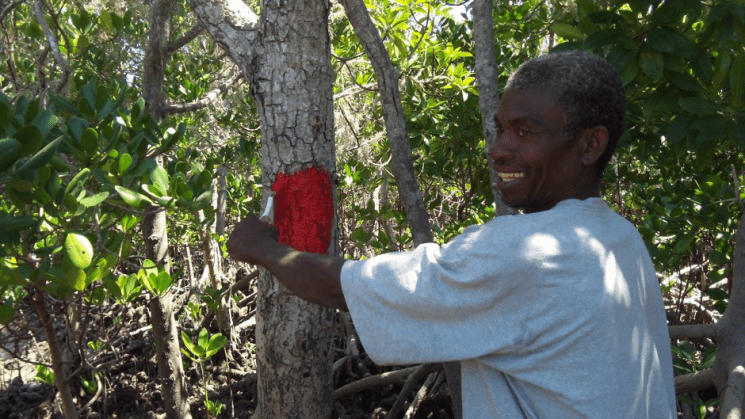This year we’re reflecting on the progress made by communities in the Bay of Assassins, Madagascar, who are leading the way in building a truly community led mangrove conservation project with the support of our Blue Forests team.
Wow, how time flies! I can’t believe it’s been more than 2 years since we started working with the communities of the Bay of Assassins – a vast mangrove bay within the Velondriake locally-managed marine area (LMMA) – to develop a Plan Vivo mangrove carbon project. Since starting the project in late-2013, we’ve completed a wide range of activities including community consultations, participatory resource mapping and theory of change, carbon fieldwork and reforestation.
Through these activities we’ve overcome numerous challenges, travelled by many different means of transport (car, zebu cart, motorised and sailing pirogues, with lots of walking in between!) and faced the climatic extremes of this coast (wind, rain and heatstroke, sometimes all in one day!).

Our zebu carts as we crossed the bay at the low tide.
But what does all this actually mean? Well aside from the huge wealth of benefits that mangroves provide communities, they’re also one of the most important ecosystems on earth in terms of atmospheric carbon sequestration. And the carbon that these forests are locking away is being released by deforestation – which for mangroves here in Madagascar is happening faster than for any other forest habitat. By calculating how much carbon is in the mangroves of the bay, and understanding how quickly these mangroves would be lost on a ‘business as usual’ scenario, we’re able to calculate how much carbon is retained in the ecosystem through Velondriake’s efforts to conserve these critically important marine forests. And by doing this, the villages of the Bay of Assassins will be able to generate Plan Vivo carbon credits; whose sale will fund and help incentivise sustainable mangrove management. The villagers chose the name ‘Tahiry Honko’ for their carbon project, which means ‘to preserve mangroves’ in our local Vezo dialect.
That we have such a large percentage of mangroves under strict conservation regulations is a testament to the communities’ commitment to protecting these forests. Central to the project’s success will be the community-designed mangrove management plans, which include sustainable harvest areas, reforestation zones and, most importantly, strict conservation areas called Tahiry Honko zones. These management plans were defined through an extensive participatory mapping campaign, during which people from each of the ten villages around the Bay deliberated and drew up the zones on printed satellite imagery. The Tahiry Honko zones cover 380 ha of the 1,500 ha of mangrove present within the Bay. Underpinning these zones are local by-laws – dinas – that govern what can and can’t be done in each zone, for example no mangrove cutting is allowed.

These missions have been an excellent opportunity for our team to work with Zo, pictured, our Geospatial Scientist who is normally based in Ambanja in the northwest of Madagascar. Following a month of training in GIS in California, USA, he shared his new skills with the team and led the delineation missions.
Mangroves are not just forests and carbon stores; they are also a critical part of Velondriake’s wider marine ecosystem, providing a safe breeding ground for many of the important fisheries in the region. Recognising the importance of the fisheries of these submerged forests as a primary source of food and income, the Bay’s communities have also prohibited night fishing and poison fishing in the Tahiry Honko areas.
This integration of fisheries measures alongside forestry regulations, in a community conservation project, is globally unique in the world of forest carbon projects, and is apt for an initiative so intrinsically linked to an LMMA.
For these zones and laws to exist on paper is one thing, but in order for local people to be clear about the location of each management zone, each area needs to be delineated – or staked – on the ground. This is no simple task, and has involved a series of zoning missions, each of which has involved three community members – each selected through open village meetings. These representatives then reported back to the all the villagers the actions taken during the delineation.
The first zone we delimited was Bejoho, an area shared by the villages of Lamboara and Ankilimalinike. It took over 2 hours in a zebu cart on a rocky road under the scorching sun to reach the site. Once there, our first task was to paint ‘Tahiry Honko’ in red paint on white plaques. The actual delineation work began at sunrise the next day, following a ‘fomba’ (ancestral rite) performed by the eldest of the community representatives. This is an important local ritual, during which elders ask for blessing from their ancestors.

Fomba – the eldest people from the delineation participants held one bottle of red rum while asking for blessing from their ancestors.

To mark the zones, trees were painted every 50 m and signs erected every 300 m, with the zoning teams navigating around buttress roots, sticking mud, and razor sharp bivalves, all of which made progress treacherous at times.
Conflicts arose at times during this process, such as when the community members didn’t agree with the zones that were defined at the village meetings. This was particularly a challenge when integrating the needs and patterns of migrant fishers, who move around a lot following fisheries throughout the year, and sometimes complained that their interests hadn’t been recognised during the zoning process. Further meetings were held to resolve this, bringing together migrants and village elders, to ensure everyone understood the zones and were happy with their location; rezoning as necessary.
It took three strenuous weeks of fieldwork and numerous follow-up consultations to ensure that everyone was happy with and understood the areas delineated as Tahiry Honko. It wasn’t easy, but we’re proud and humbled at the result: 380 ha of Tahiry Honko zones are now zoned on the ground, which is a massive achievement for the communities of the Bay of Assassins, and will pave the way for mangrove conservation and future income from carbon credits. Through the process we’ve learnt a lot about the communities of this remarkable bay, and also forged some great friendships with local people by working closely together in the challenging field environment. Next step……the sustainable harvest and reforestation zone delineations! Someone pass the sunscreen and water 🙂
We would like to thank the MacArthur Foundation and the GEF Blue Forests project for supporting this work, and also recognise the Darwin Initiative for earlier support of our Blue Forests initiative.
Find out more about our work conserving Madagascar’s blue forests here. The Tahiry Honko community carbon project is featured in this film.

